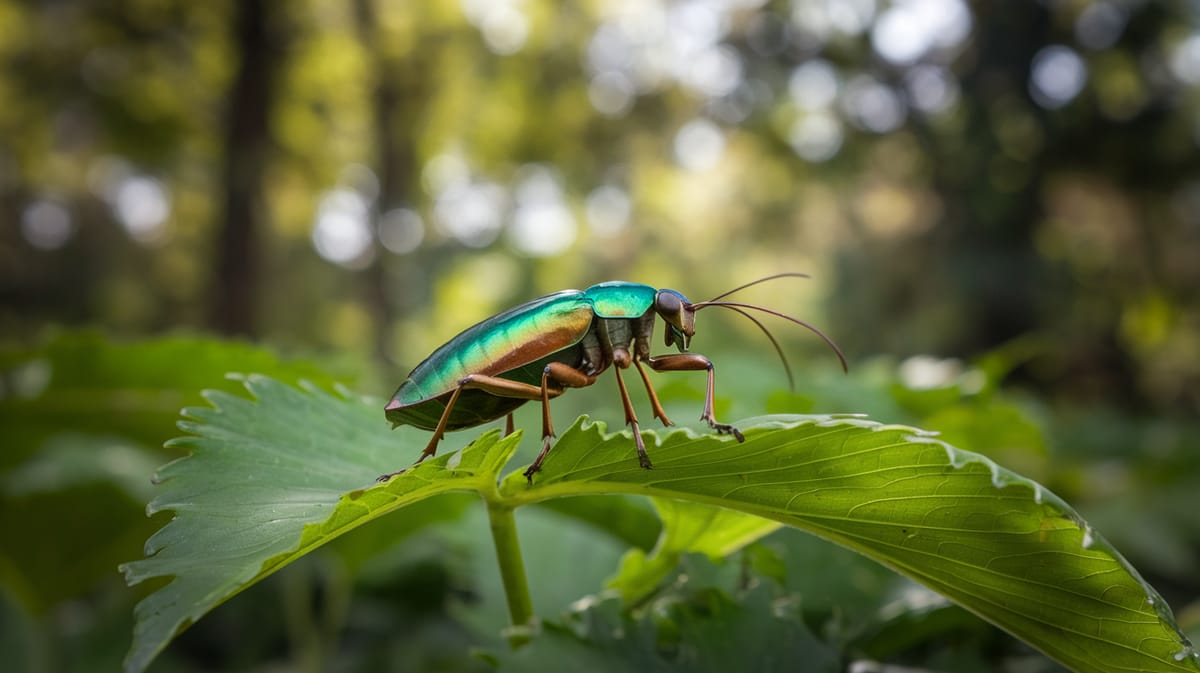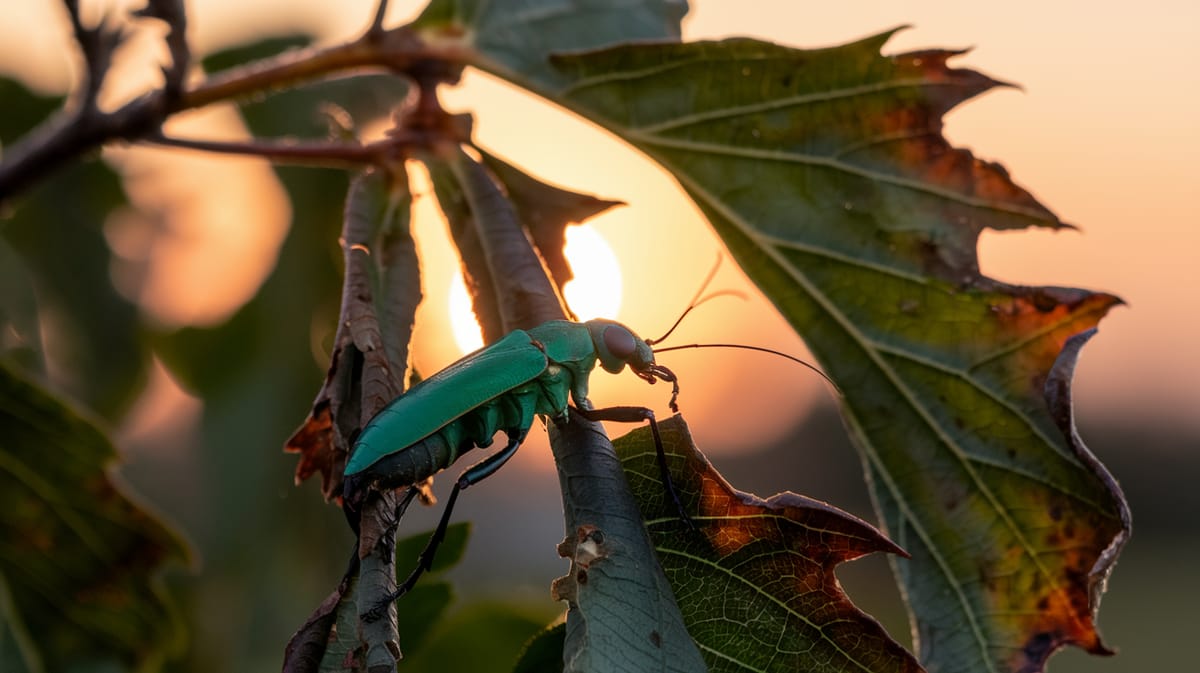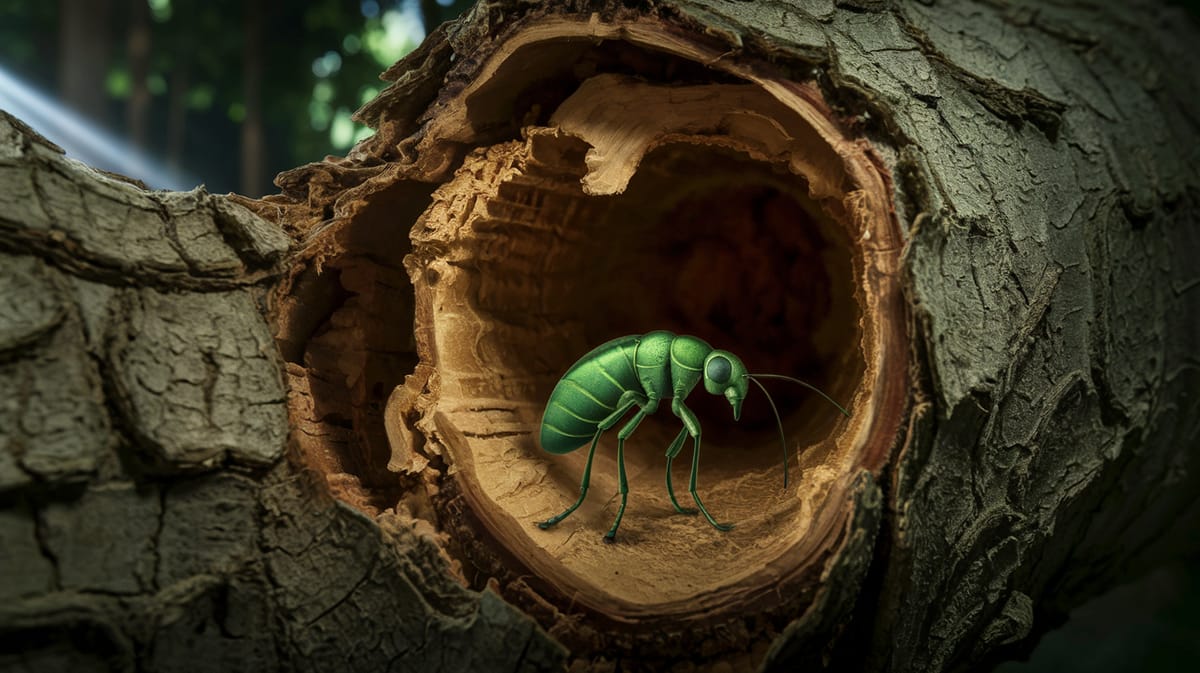Emerald Ash Borer
Emerald Ash Borer, a jewel-toned invader, silently decimates North American ash trees with its relentless larvae. Its stealthy nature makes it a formidable forest adversary.

Key Insights at a Glance
Did You Know?
Taxonomy & Classification
The Emerald Ash Borer, a notorious tree killer, evolved with specialized adaptations for boring into ash trees, making them formidable pests in their ecological niche. Let's understand the evolutionary journey and classification of these remarkable herbivores.
Global Distribution
Native to Asia, Emerald Ash Borers have spread to North America, threatening millions of ash trees with significant ecological and economic impacts.
Evolutionary Adaptations
Evolving over 35 million years, these beetles developed efficient wood-boring capabilities, allowing them to thrive and spread across diverse habitats.
Lifecycle and Growth
A remarkable journey of transformation from Egg to Adult.
Egg
Females lay eggs in bark crevices, where they develop under protective layers until hatching into larvae.
Larva
Larvae burrow into the tree, feeding on inner bark and creating serpentine galleries that disrupt nutrient flow.
Pupa
Pupation occurs in the tree; larvae transform into adults with metallic green exoskeletons and developed wings.
Adult
Adults emerge in summer, feeding on foliage and mating, with females laying up to 100 eggs each.
Dietary Habits
A voracious feeder with specialized adaptations, this insect targets tree bark, causing significant damage to its primary food source.
| DIET TYPE | DESCRIPTION |
|---|---|
| Primary Diet | Larvae primarily consume the inner bark of ash trees, disrupting nutrient flow. |
| Secondary Diet | Occasionally feeds on stressed or dying trees, exploiting weakened defenses to thrive. |
| Occasional | Rarely targets other tree species if ash trees are scarce, showcasing adaptability to limited resources. |

Behaviour and Adaptations
Discover the remarkable capabilities that make the Emerald Ash Borer a formidable invader of ash trees.
Larval Boring Efficiency
Larvae tunnel through ash tree bark, disrupting nutrient flow and causing tree death.
Host Selection
Adults preferentially target ash trees, ensuring larvae have optimal growth conditions.
Flight Dispersal
Capable fliers that spread efficiently to new areas, aiding infestation.
Ecosystem Impact
Emerald Ash Borers contribute to ecological balance by influencing forest dynamics and supporting biodiversity.
Decomposer Facilitator
Accelerates decomposition by increasing dead ash wood, aiding nutrient cycling.
Biodiversity Booster
Creates habitats for other species by increasing deadwood availability.
Predator Support
Attracts predators like woodpeckers, aiding in natural population control.
Conservation Challenges
Understanding and addressing the major threats to Emerald Ash Borer populations.
Habitat Destruction
Deforestation and urbanization reduce ash tree availability, threatening borer habitats.
Climate Change
Changing weather patterns affect ash tree health, impacting borer survival.
Natural Predators
Predators and parasites can significantly reduce borer populations.
Frequently Asked Questions
How long do Emerald Ash Borer live?
Emerald Ash Borer adults typically live for about three to six weeks. They emerge from ash trees from late spring to early summer, mate, and lay eggs. The larvae can take about a year to develop inside the tree before emerging as adults.
What do Emerald Ash Borer eat?
Emerald Ash Borer larvae feed on the inner bark of ash trees. This feeding disrupts the tree’s ability to transport water and nutrients, effectively girdling the tree and leading to its death over time. Adult Emerald Ash Borers feed on ash tree foliage.
Are Emerald Ash Borer poisonous?
Emerald Ash Borers are not poisonous to humans or pets. The threat they pose is ecological, as they can cause significant damage to ash tree populations, leading to economic and environmental impacts. Ingestion by birds or other animals does not appear to be harmful.
Are Emerald Ash Borer endangered?
Emerald Ash Borers are not considered endangered. They are, in fact, an invasive species in North America, originally from Asia. Their population has grown significantly since their introduction, causing widespread damage to ash trees across affected regions.
What do Emerald Ash Borer symbolize?
Emerald Ash Borers don’t have a widely recognized symbolic meaning. However, in regions affected by their invasion, they often represent ecological imbalance and the impact of invasive species on native ecosystems and biodiversity. Their presence highlights the importance of forest management and conservation efforts.
Do Emerald Ash Borer bite?
Emerald Ash Borers do not bite humans or animals. They pose no direct threat to people. Their primary concern is their destructive impact on ash trees, where larvae feed on the inner bark, weakening and often killing the trees over time.
What color are Emerald Ash Borer?
Adult Emerald Ash Borers are bright metallic green, giving them their name. Their vibrant color makes them distinctive among other beetles. The larvae, which are less often seen, are cream-colored and found beneath the bark of ash trees.
Does a Emerald Ash Borer have wings?
Yes, an Emerald Ash Borer has wings. Adult beetles have two pairs of wings: a hard outer pair that covers their body and a softer inner pair used for flying. Their wings are part of what makes them effective dispersers in new environments.
What does a Emerald Ash Borer look like?
An adult Emerald Ash Borer is a small, metallic green beetle about half an inch long and an eighth of an inch wide. They have a flat back with a rounded belly, and their body is elongated and narrow, making them easily recognizable.
Is a Emerald Ash Borer an insect?
Yes, the Emerald Ash Borer is an insect. Specifically, it is a beetle belonging to the family Buprestidae, known for their metallic colors and wood-boring larvae. As an insect, it undergoes complete metamorphosis with egg, larval, pupal, and adult stages.
Related Insects
Discover insects with similar characteristics to Emerald Ash Borer - including shared habitats, diets, and taxonomic classifications
Share this profile
Help others discover Emerald Ash Borer
